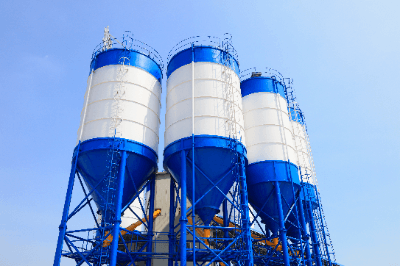What Is a Stirring Tank?

A stirring tank is a tank used for stirring.
Different solids, liquids, and gases are placed in a stirring tank to stir and mix them. The shape of a stirring tank is indicated by the ratio of the liquid surface height to the tank’s inner diameter. Generally, an efficient ratio is around 1.0 to 1.5.
If the stirring tank is excessively thin, the top and bottom sides of the tank will not be stirred properly and a concentration gradient will easily occur, while if the tank is excessively thick, the tank diameter will increase, requiring a thicker tank.
Uses of Stirring Tanks
Stirring tanks are used as the exterior of an agitator that mixes substances. Depending on the use of the stirring tank, components such as coils, jackets, baffles, and nozzles are installed. When installing components, they must not obstruct the flow of liquid through the agitator and must be structurally strong.
Coils and jackets are used for heating and cooling. Baffles are responsible for imparting vertical flow to the horizontal flow of liquid, and for maximum effectiveness, 2 to 8 baffles should be installed for a tank.
Nozzles are used for injecting and draining liquid in the tank, and when gas is injected into the liquid, it can also be put in through nozzles at the bottom of the tank for bubbling.
Principle of Stirring Tanks
A stirring tank consists of a motor, reduction gear, shaft sealing device, shaft, stirring blades, and baffles.
1. Shaft Sealing Device
The motor rotates and transmits power to the shaft, which, when equipped with a reduction gear, decelerates and increases torque in accordance with the reduction gear. The shaft sealing device will seal the inside of the tank without interfering with rotation. Commonly used shaft sealing devices are gland packings and mechanical seals.
2. Agitation Blades
The shaft rotates at the same time as the agitator blades rotate, enabling the liquid to be agitated. Agitation in the stirring tank is caused by thrust and radial forces depending on the shape of the stirring tank blades. In addition, the liquid in contact with the agitation blades flows vertically and horizontally, resulting in the unique behavior of the agitation blades.
3. Baffling
The agitated liquid can be further dispersed by baffles installed in the tank. Baffles are used to change the flow from laminar to turbulent. Baffles are especially effective when agitating low viscosity liquids, which tend to become laminar.
4. Tank
The shape of the tank changes the degree of liquid dispersion. The shape of the tank bottom has a particularly large effect on liquid accumulation. Commonly used is a 2:1 semi-elliptical or 10% dish shape. If the ratio of the height of the liquid surface to the tank’s inner diameter is 1.2, the tank’s inner diameter can be calculated by multiplying the liquid volume by 1.14 and then multiplying by 1/3.
Other Information on Stirring Tanks
1. Type of Agitating Blade
The part that transmits the rotation of the motor to the stirring tank and agitates the material is the agitating blade. The role of the agitation blade can be broadly divided into two: “shearing action,” which provides shear force to various parts of the stirring tank, and “circulating action,” which provides the formation of a circulating flow. Based on the viscosity of the material to be agitated, an agitation blade with the optimum balance that can achieve the objective is selected.
Typical stirring blades used in stirring tanks are as follows
Propeller Blades
Propeller blades are three-winged agitation blades used on ships. They are not suitable for agitating high-viscosity materials, but are used to prevent sedimentation when individual particles are contained in low-viscosity liquids. Other than that, they are widely used as standard agitation blades due to their cost and compactness.
Disk Turbine Blade
Disk turbine blades are agitator blades consisting of a disk with several blades attached to it. Although they consume a lot of power, they generate a large circulating and shearing action. They can be used for agitation while pulverizing solids, and for agitation with reactions such as gas dispersion and absorption.
Anchor Blade
Anchor blades are agitation blades shaped like a ship’s anchor. Generally, these stirring blades are shaped from the bottom of the stirring tank along the wall. Although they can agitate high-viscosity materials, their agitation capacity is not as high as that of other agitator blades.
2. Types of Stirring Tanks
There are several types of stirring tanks. It is important to select a stirring tank according to the stirring method appropriate for the liquid to be mixed.
Central Agitation
This is a stirring method in which the middle axis of the stirring blade is vertically attached to the center of the stirring tank. This is a common method and is characterized by uniform flow.
Eccentric Inclined Agitation
This is an agitation method in which the stirring blades are installed not in the center of the stirring tank but at an angle to the bottom surface. Even without baffles, turbulent flow can be generated.
Bottom Agitation
This is an agitation method in which the stirring blades are attached from the bottom of the stirring tank. When the stirring tank is large, the attachment of a long shaft becomes unnecessary.